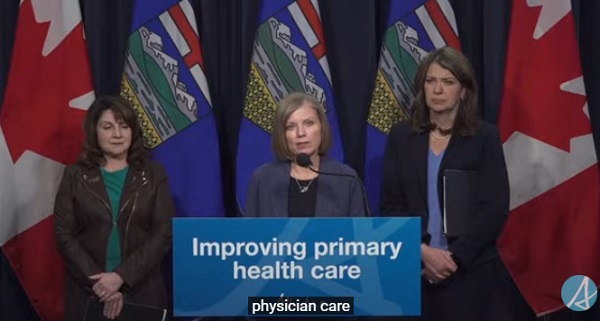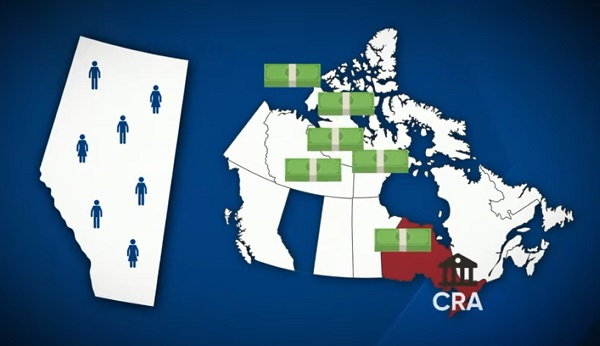Alberta
Province says Alberta family doctors will be the best-paid and most patient-focused in the country

Dr. Shelley Duggan, president, Alberta Medical Association
New pay model, better access to family doctors |
Alberta’s government is implementing a new primary care physician compensation model to improve access to family physicians across the province.
Alberta’s government recognizes that family physicians are fundamental to strengthening the health care system. Unfortunately, too many Albertans do not currently have access to regular primary care from a family physician. This is why, last year, the government entered into a memorandum of understanding with the Alberta Medical Association (AMA) and committed to developing a new primary care physician compensation model.
Alberta’s government will now be implementing a new compensation model for family doctors to ensure they continue practising in the province and to attract more doctors to choose Alberta, which will also alleviate pressures in other areas of the health care system.
This new model will make Alberta’s family doctors the strongest-paid and most patient-focused in the country.
“Albertans must be able to access a primary care provider. We’ve been working hard with our partners at the Alberta Medical Association to develop a compensation model that will not only support Alberta’s doctors but also improve Albertans’ access to physicians. Ultimately, our deal will make Alberta an even more attractive place to practise family medicine.”
“We have worked with the Alberta Medical Association to address the challenges that primary care physicians are facing. This model will provide the supports physicians need and improve patient access to the care they need.”
The new model is structured to encourage physicians to grow the number of patients they care for and encourage full-time practice. Incentives include increases for:
- Maintaining high panel numbers (minimum of 500 patients), which will incentivize panel growth and improve access to primary care for patients.
- Providing after-hours care to relieve pressure on emergency departments and urgent care centres.
- Improving technology to encourage using tools that help streamline work and enhance patient care.
- Enhancing team-based care, which will encourage developing integrated teams that may include family physicians, nurse practitioners, registered nurses, dietitians and pharmacists to provide patients with the best care possible.
- Adding efficiencies in clinical operations to simplify processes for both patients and health care providers.
As a market and evidence-based model, it recognizes and pays for the critically important work of physicians, including the number of patients seen and patient complexity, as well as time spent providing direct and indirect care.
“Family medicine is the foundation of our health care system. This model recognizes the extensive training, experience and leadership of primary care physicians, and we hope it will help Alberta to attract and retain more family medicine specialists who provide comprehensive care.”
Additionally, family physicians who are not compensated through the traditional fee-for-service model will now receive higher pay rates under their payment model, known as the alternative relationship plan. This includes those who provide inpatient care in hospitals and rural generalists. Alberta’s government is increasing this to ensure hospital-based family physicians and rural generalists also receive fair, competitive pay that reflects the importance of these roles.
“This new compensation model will make Alberta more attractive for physicians and will make sure more Albertans can have improved access to a primary care provider no matter where they live. It will also help support efforts to strengthen primary care in Alberta as the foundation of the health care system.”
“Family physicians have been anxiously awaiting this announcement about the new compensation model. We anticipate this model will allow many primary care physicians to continue to deliver comprehensive, lifelong care to their patients while keeping their community clinics viable.”
Quick facts
- Enrolment in the primary care physician compensation model will begin in January with full implementation in spring 2025, provided there are at least 500 physicians enrolled.
- The alternative relationship plan rate has not been updated since it was initially calculated in 2002.
- The new compensation model for family doctors is the latest primary health care improvement following actions that include:
- A $42-million investment to recruit more health providers and expand essential services.
- A new rural and remote bursary program for family medicine resident physicians.
- Additional funding of $257 million to stabilize primary care delivery and improve access to family physicians.
- Implementing the Nurse Practitioner Primary Care Program, which expands the role of nurse practitioners by allowing them to practise comprehensive patient care autonomously, either by operating their own practices or working independently within existing primary care settings.
Related information
Alberta
Temporary Alberta grid limit unlikely to dampen data centre investment, analyst says
From the Canadian Energy Centre
By Cody Ciona
‘Alberta has never seen this level and volume of load connection requests’
Billions of investment in new data centres is still expected in Alberta despite the province’s electric system operator placing a temporary limit on new large-load grid connections, said Carson Kearl, lead data centre analyst for Enverus Intelligence Research.
Kearl cited NVIDIA CEO Jensen Huang’s estimate from earlier this year that building a one-gigawatt data centre costs between US$60 billion and US$80 billion.
That implies the Alberta Electric System Operator (AESO)’s 1.2 gigawatt temporary limit would still allow for up to C$130 billion of investment.
“It’s got the potential to be extremely impactful to the Alberta power sector and economy,” Kearl said.
Importantly, data centre operators can potentially get around the temporary limit by ‘bringing their own power’ rather than drawing electricity from the existing grid.
In Alberta’s deregulated electricity market – the only one in Canada – large energy consumers like data centres can build the power supply they need by entering project agreements directly with electricity producers.
According to the AESO, there are 30 proposed data centre projects across the province.
The total requested power load for these projects is more than 16 gigawatts, roughly four gigawatts more than Alberta’s demand record in January 2024 during a severe cold snap.
For comparison, Edmonton’s load is around 1.4 gigawatts, the AESO said.
“Alberta has never seen this level and volume of load connection requests,” CEO Aaron Engen said in a statement.
“Because connecting all large loads seeking access would impair grid reliability, we established a limit that preserves system integrity while enabling timely data centre development in Alberta.”
As data centre projects come to the province, so do jobs and other economic benefits.
“You have all of the construction staff associated; electricians, engineers, plumbers, and HVAC people for all the cooling tech that are continuously working on a multi-year time horizon. In the construction phase there’s a lot of spend, and that is just generally good for the ecosystem,” said Kearl.
Investment in local power infrastructure also has long-term job implications for maintenance and upgrades, he said.
“Alberta is a really exciting place when it comes to building data centers,” said Beacon AI CEO Josh Schertzer on a recent ARC Energy Ideas podcast.
“It has really great access to natural gas, it does have some excess grid capacity that can be used in the short term, it’s got a great workforce, and it’s very business-friendly.”
The unaltered reproduction of this content is free of charge with attribution to the Canadian Energy Centre.
Alberta
Alberta Next: Taxation

A new video from the Alberta Next panel looks at whether Alberta should stop relying on Ottawa to collect our provincial income taxes. Quebec already does it, and Alberta already collects corporate taxes directly. Doing the same for personal income taxes could mean better tax policy, thousands of new jobs, and less federal interference. But it would take time, cost money, and require building new systems from the ground up.
-

 Fraser Institute2 days ago
Fraser Institute2 days agoBefore Trudeau average annual immigration was 617,800. Under Trudeau number skyrocketted to 1.4 million annually
-

 MAiD2 days ago
MAiD2 days agoCanada’s euthanasia regime is already killing the disabled. It’s about to get worse
-

 Frontier Centre for Public Policy1 day ago
Frontier Centre for Public Policy1 day agoNew Book Warns The Decline In Marriage Comes At A High Cost
-

 Business2 days ago
Business2 days agoPrime minister can make good on campaign promise by reforming Canada Health Act
-

 Addictions1 day ago
Addictions1 day ago‘Over and over until they die’: Drug crisis pushes first responders to the brink
-

 International2 days ago
International2 days agoChicago suburb purchases childhood home of Pope Leo XIV
-

 Daily Caller1 day ago
Daily Caller1 day agoUSAID Quietly Sent Thousands Of Viruses To Chinese Military-Linked Biolab
-

 Energy1 day ago
Energy1 day agoLNG Export Marks Beginning Of Canadian Energy Independence


